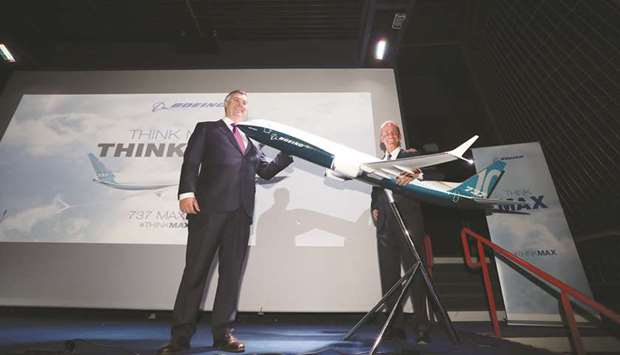A carefully packaged week of announcements created momentum that Boeing has struggled to display in recent years after being outmanoeuvred for sales of single-aisle planes since the pair decided to upgrade their best-selling models early this decade.
Boeing has seen its market share fall from 50% to around 42% for the latest models, partly because the Airbus A320 family’s design allowed it to use a larger version of the latest generation of engines, which helps in some cases.
It was the first show in their respective roles for ex-General Electric executive Kevin McAllister, the first outsider hired to run Boeing’s commercial division, and Ihssane Mounir, recently made sales chief after fighting Airbus in North Asia.
Its outcome reflects a “more aggressive marketing strategy” at the US company, Jefferies analyst Howard Rubel wrote in a note.
Boeing got 361 orders and commitments for the 737 MAX 10 from 16 customers, including 147 incremental ones.
Reuters had reported it would win close to 150 incremental orders.
“It’s a fightback. It goes back to (McAllister’s predecessor) Ray Conner’s recent talk about winning markets,” said Nick Cunningham, analyst at UK-based Agency Partners.
“The battle showed itself in price and is now beginning to show itself in products.” Boeing’s energy contrasted with a flatter tone than usual from Airbus, even though it too won more orders than expected.
It suggests Boeing will be looking to maintain last week’s momentum as it tries to poach Airbus customers without the previous disadvantage of an uneven portfolio dependent mainly on the smaller MAX 8, industry sources said.
That could result in bruising battles as Boeing’s fired-up new management targets Airbus customers while working on a separate new mid-sized aircraft project for next decade.
Airbus denied it had lost any momentum. Its executives painted the 737 MAX 10 as something forced on Boeing to defend a weak market share, and highlighted the more than 200 conversions to 737 MAX 10s from existing Boeing orders.
Some questioned whether all buyers would stick with the model.
“It was a good PR exercise. I am not so sure if there was as much quality or substance to they deals they did at the air show,” said Kiran Rao, recently designated as successor to Airbus sales chief John Leahy, who retires this year.
Analyst Scott Hamilton of Leeham News played down Airbus’s objection about conversions, saying switching up in size is standard and noting the important backing of United Airlines for the new Boeing model. Still, industry sources said Boeing’s decision to launch the 737 MAX 10, seating up to 230 people, was a twin defensive move.
Most attention focused on Boeing’s need to fix a gap in seats at the top end of its single-aisle portfolio against the A321neo, which Airbus says can seat up to 240 people.
But Boeing had a second reason to launch the 737 MAX 10. Industry sources say it had grown increasingly worried about losing sales of its main cash cow, the MAX 8, through the back door because of interlocking relationships between models.
Alarm bells began ringing at the same air show two years ago when Korean Air split a $6.9bn order for narrow-body jets between the A321neo and Boeing 737 MAX 8.
The success of the A321neo created the threat that Boeing customers who needed a high proportion of the larger category in their fleets could pick the A321neo, and then take the 150-seat A320neo by default to avoid the inefficiency of two types. Airbus says the A321neo size will make up half the single- aisle market, worth $3 tn over 20 years.
Boeing says it will be closer to 25%. But even at Boeing’s lower estimate, the success of the A321neo handed Airbus a powerful lever to make inroads into the rest of Boeing’s fleet and damage its biggest-selling product.
“It was a threat. Boeing needed to defend the 737 MAX 8,” a senior aircraft leasing company executive said.
The grab for market share, which began under soon-to-retire Boeing vice chairman Ray Conner, who handed the commercial unit to McAllister in November, still leaves Boeing trailing Airbus.
“It improves the 737’s competitive position but does not resolve it entirely,” Cunningham said.
Mounir rejected a suggestion that Boeing had approached the air show in the spirit of ‘attack is the best form of defence’.



